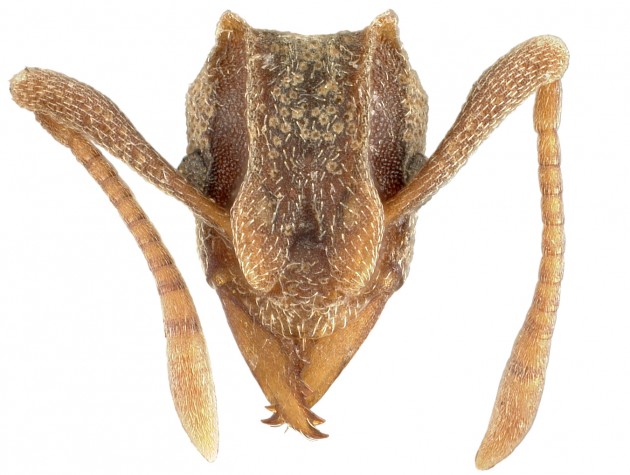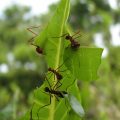By John Barrat

The fungus-farming ants C. wheeleri have been faithful to the same fungus for some 5 million years. (Photos courtesy Ted Schultz)
When the time comes to fly away from home and start a nest of her own, the daughter queen of a fungus-farming ant colony departs with a small bit of fungus from her mother’s nest in her mouth. When the daughter arrives at a suitable destination she spits it out and, very carefully, tends this precious starter culture until it blossoms into a flourishing fungus garden capable of sustaining an entire colony of tens of thousands of ants.
Now, using DNA analysis of a particular subgroup of both the ants and the fungi they nurture in their underground nests, scientists have discovered an incredible story of fungal fidelity. Not only do individual species of these ants raise only one specific species of fungi, but DNA analysis and computer modeling reveal some ant species have been true to the same fungal species for more than 5 million years!
“Most scientists who study fungus-farming ants have long assumed the same ant species grows a variety of different fungi,” explains Ted Schultz, entomologist at the Smithsonian’s National Museum of Natural History. “When we saw the DNA results showing such strong faithfulness to one specific fungi species we were really surprised. We weren’t expecting this at all.”
“The larger group of fungi farmed by these ants contains 100 or more species, many of which are readily available in the environment, or from other ant nests,” Schultz explains. “For reasons we don’t understand, ant species in the group that we studied are very faithful to a single cultivar species of fungi.”
The discovery was made possible, Schultz explains, because for the first time “we used a big sample of ants and fungi collected from nests across a wide geographic range,”–Panama, Ecuador, the United States and Costa Rica. “This showed us a pattern that we would have otherwise been unable to see.”
While there are roughly 240 species of fungus farming ants known to scientists, the study focused on a small group of six species, scientifically known as: Cyphomyrmex faunulus, C. strigatus; C. costatus; C. wheeleri; C. longiscapus and C. muelleri. Despite having been collected thousands of miles apart across a wide geographic area each individual ant species was found to cultivate the same individual fungus. Fungi were different between the ant species.
“Using a computer program that can reconstruct the ancestral state of the ants and fungi using the molecular DNA sequences and the branches of the ancestral family trees for both ants and fungi, calculations indicate these ants have been growing each fungus species for a minimum of 5 million years,” Schultz says. One species, C. longiscapus, was shown to have been associated with a specific fungus for a little over 9 million years.
“In very rare instances when an ant species changes its fungal cultivar,” Schultz says, “it appears that the ant becomes a new species. So it seems that among ants, the fungus they grow determines the species they are. The reason this might happen, and this is just speculation, is that how an ant smells depends upon what fungus it grew up with. And ants only mate with others that smell like them. So should a population of ants change their fungus, then it may cause them to stop mating with their ancestral population.”
Article link: Symbiont fidelity and the origins of species in fungus growing ants, Nature, May 15, 2012.






